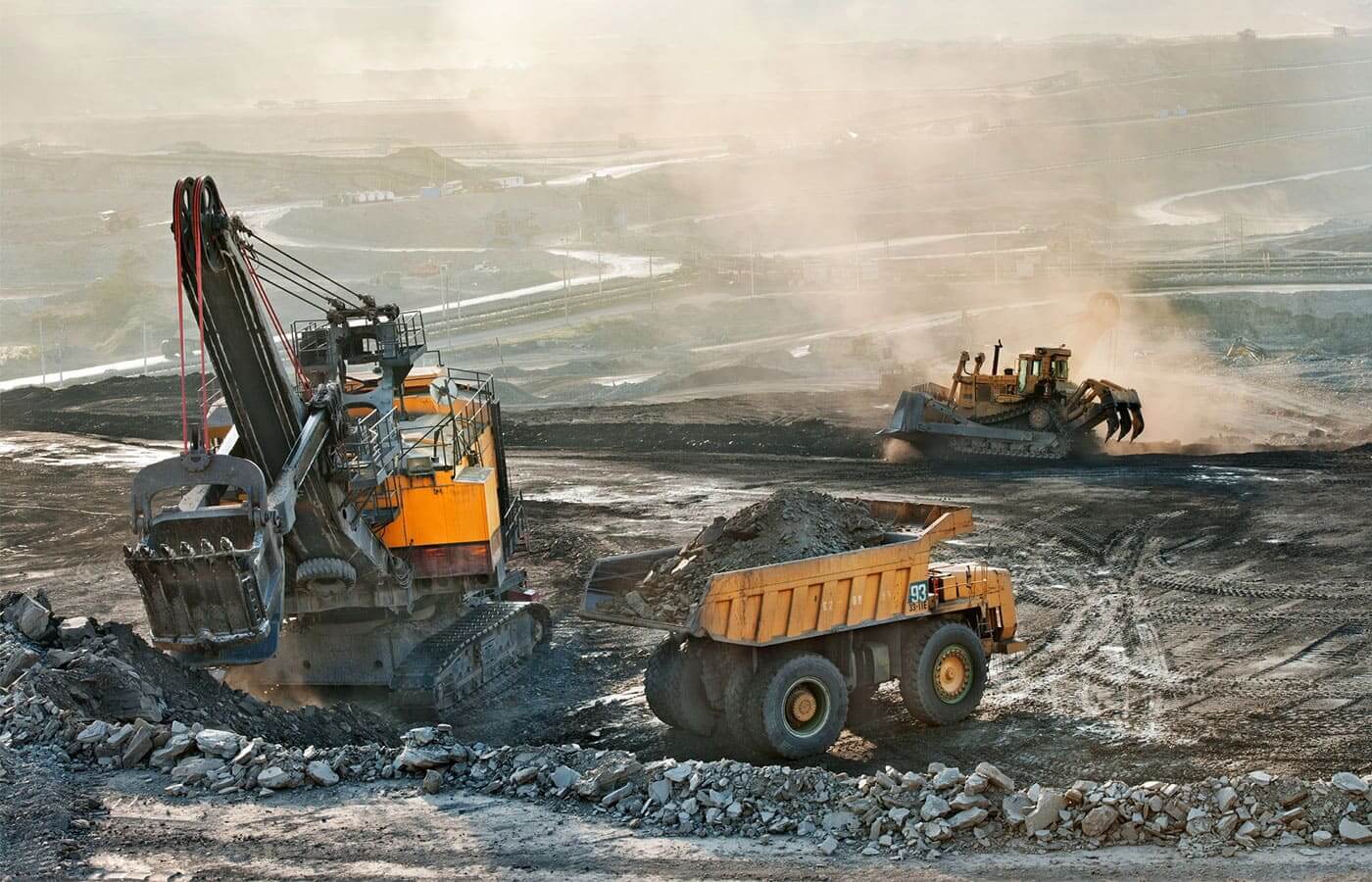Investing in mining stocks and shares is often a popular move for income investors. Despite the relatively high-risk nature of this stock market sector, especially for younger players, these businesses often return a significant amount of capital to shareholders through dividends.
There is always a demand for natural resources in a world that’s ever-growing in population. But with the rise of electric vehicle stocks and renewable energy shares, demand for 21st-century metals has never been higher. And with inflation causing economic disruption, gold mining has also gained further popularity.
That being said, let’s take a closer look at the mining industry, the market leaders, profit potentials, risks and, of course, the projection of its market size.
What are Mining Stocks?
Mining stocks are the companies involved in exploring, extracting, and producing natural resources. The sector is actually one of the largest contributors to the global economy. And in countries like Australia, one of the biggest employers as well.
The demand for raw materials is inexhaustible. As the planet’s population growth continues, demand for new products will undoubtedly rise. Yet the finite nature of the Earth’s resources is what drives value. For example, cobalt is one of the critical ingredients in lithium-ion batteries. But most of the world’s supply is found in the Democratic Republic of the Congo – an area not exactly known for its geopolitical or moral stability.
The difficulty often makes the available supply for some metals quite limited. And when combined with spikes in demand, it sends the commodity prices sky-high. But while supply remains relatively consistent (ignoring the exceptional conditions of the pandemic), demand constantly fluctuates, which in turn makes this a highly cyclical industry. Obviously, this is a risk that needs to be considered before investing in mining stocks and shares.
As operating expenses for these companies are largely fixed, when commodity prices climb, the increase translates into almost pure profit. But when prices fall, profits can very quickly disappear, even for the most established enterprises.
There is no doubt that mining has played a crucial role in the stability of the world’s economy. But it’s important there are several different kinds of mining businesses out there:
- Exploration – These companies are at the first step of their development cycle. These are the firms going around performing surveys to try and find a suitable and profitable mineral deposit to begin extraction. The surveying process is not cheap. And it’s not uncommon for a mining stock to announce it’s found an amazing place to dig only to discover that the drilling tests reveal it’s either not as good as originally thought or is economically unviable to extract. Mining shares in the exploration phase are entirely driven by expectations rather than fundamentals, making investing in them exceptionally high-risk.
- Development – Once the exploration phase is complete and a digging site is ready to be constructed, the development phase starts. These companies often don’t have any source of revenue and are therefore reliant on external funding for the capital-intensive process of building a site. Typically mining stocks will sell a royalty agreement with a more established company. In exchange for initial up-front capital, they agree to give a certain percentage of the minerals extracted once digging begins. This can lead to large chunks of the potential profits going to another company, but it also prevents any shareholder equity dilution and keeps the balance sheet unlevered.
- Production – Once a site is established, production begins. These businesses finally have revenue flowing through the door and can quickly become profitable depending on how commodity prices fluctuate. This is the category under which most industry leaders like Rio Tinto, BHP Group, Glencore, and Vale reside.
- Royalties – A less common class of mining stock is the royalties business. These firms provide initial funding for exploration and development in exchange for a percentage cut of extracted products in the future. Examples include Anglo Pacific Group and Trident Royalties.

What are the Main Risks and Challenges to Mining Shares?
Like every other investment, investing in mining shares has its risks. And for younger companies, these challenges can often lead to complete failure.
- Demand & Supply Imbalance – The demand for natural resources seems to be surging at the moment. However, this is not the case for the supply of raw materials. When an investor buys a mining stock, and the company cannot mine sufficiently to meet the demand, it often results in another mining business swooping in and capitalising on the opportunity to steal market share.
- Prices Instability – The mining industry is plagued by price volatility in natural resources. Where there is an increased demand for a particular commodity, and its supply has limited, the price will surge. But when there is less demand and more supply, the price of the resource will quickly decline.
- Environmental Concerns – The effect of mining has serious consequences on the environment. This can be directly or indirectly. Some of the consequences are pollution, destruction of land, impact on the biological environment, etc. This has raised so much concern about looking for a more efficient way to carry out mining which will be more eco-system friendly. Where these concerns are substantiated, an alternative to mining could be sourced.
- Regulatory Compliance – Before any business can begin mining, it needs to secure the necessary permits from the government in the country the site exists. This is often easier said than done. But even after permission is granted, it can always be revoked if the group fails to comply with local regulations.
- Safety – Despite vast improvements in the safety procedures and equipment used today, mining accidents still happen. And these can be fatal. From an investor’s perspective, this creates delays in subsequent investigations, which can lead to substantial legal penalties if improper conduct is discovered.
Key Financial Metrics
Analysing a mining stock can be a pretty tricky process. The lack of consistency makes it difficult to judge, especially for younger players in the sector. But in my experience, there are some financial metrics that do shed some light.
- Inventory Turnover – This metric shows the rate a company sells and replaces its inventory over a period. A high ratio points to a strong sale, while a low ratio points to a weak sale.
- Net Margin – Reveals the net income or profit generated as a percentage of the revenue. Generally, a 10% margin is considered average; 20% is considered high, while 5% is low.
- Profit Margin Ratio – Reveals how much profit a company makes from every dollar of sale.
- Price-to-Earning (P/E) Ratio – This measures the ratio of a company’s share price to its earnings per share. The P/E ratio helps the investor to know when a company is undervalued or overvalued.
- Return-on-Equity (ROE) – ROE helps the investor to know how well a company manages the investor’s money. A high ROE is preferred. It is calculated by dividing the net income by the shareholders’ equity.
- Debt-to-Asset Ratio – Compares a firm’s debt obligations to its total assets. This is a quick method of evaluating the degree of financial leverage for a business. And typically, a value below 1.0 is desirable to most investors.
Key Terms when Investing in Mining Stocks
This industry is complicated, to say the least. There is a lot of jargon out there. And The Money Cog has a guide specifically for understanding drilling results. But, let’s take a look at some of the most common terminologies that tend to pop up.
- Alloy – A compound of two or more metals.
- Geology – The science concerned with the study of the rock which composes the Earth.
- Lode – A mineral deposit in solid rock.
- Leachable – Extraction by chemical solvent.
- Oxidation – A chemical reaction caused by exposure to oxygen that results in a change in the chemical composition of minerals.
- Crust – The outermost layer of the Earth.
- Bulk mining – A large scale mechanised method of mining involving many thousands of tonnes of ore.
- Ore Grade – A measure of quality for the mineral deposit being extracted.
What is the market size?
According to a report by The Business Research Company, the global mining market climbed to $1.84trn in 2021. And it’s expected to continue growing at a compounded annual growth rate of 12.9% between 2022 and 2026 reaching $3.36trn. Needless to say, that’s quite a large investment opportunity for my portfolio.
The Asia Pacific region has the largest global mining market share accounting for 70.5% of the sector. This was followed by North America, West Europe and the other regions. However, South America and the Middle East are predicted to be the fastest-growing going forward.
But the extraction of resources is not the only area to consider when thinking about investing in mining stocks and shares. This process requires lots of machinery and equipment. Consequently, this part of the market has expanded considerably in recent years.
The global mining machinery and equipment market was valued at $62.02bn in 2021 and is projected to reach $111.95bn by 2026 at a similar compounded annual growth rate of 12.3%.
Top mining stocks in the UK by Market Capitalisation
The table below shows the top mining stocks in the UK by market capitalisation.
| Company | Market Cap. | Category | Description |
|---|---|---|---|
| Rio Tinto (LSE:RIO) | £71.83bn | Exploration, Development, Production | The mining company explores, mines and processes mineral resources. |
| Glencore (LSE:GLEN) | £68.63bn | Exploration, Development, Production | Engages in trading and mining of diversified natural resources. |
| BHP Group (LSE:BHP) | £53.12bn | Exploration, Development, Production | Engage in the mining of metals and petroleum |
| Anglo America (LSE:AAL) | £52bn | Exploration, Development, Production | Explore and mine various mineral resources |
| Antofagasta (LSE:ANTO) | £14.57bn | Exploration, Development, Production | Engages in the exploration and mining of copper. |
Top Mining stocks in the US by Market Capitalisation
The table below lists the top mining stocks in the US by market capitalisation.
| Company | Market Cap. | Category | Description |
|---|---|---|---|
| Freeport- McMoRan (NYSE:FCX) | $60.25bn | Exploration, Development, Production | Engage in the exploration and mining of copper, gold and molybdenum. |
| Newmont Corporation (NYSE: NEM) | $54.35bn | Exploration, Development, Production | Exploration and mining of gold. They also own a very large gold reserve. |
| Southern Copper Corporation (NYSE:SCCO) | $49.05bn | Exploration, Development, Production | Engage in the mining, exploration, smelting and refining of copper and other minerals. |
| Barrack Gold Corporation (NYSE:GOLD) | $37bn | Exploration, Development, Production | Explores and mines for gold and copper. |
| Teck Resources (NYSE:TECK) | $24bn | Exploration, Development, Production | Exploration and mining of various mineral resources. |
Should I Invest in Mining Stocks?
The mining sector is a cyclical one. There are various opportunities for me since the industry has hundreds of companies to choose from. Investors can either buy the stocks of major or mining companies depending on the risk level such an investor is ready to take. But even the larger players may prove to be too risky for some investors who aren’t comfortable with the rapid price fluctuations of commodities.
Notwithstanding the opportunities, investing in mining stocks and shares requires the investor to take a critical analysis of the profile of the companies. Personally, I’ve found this sector to be an enticing source of passive income, and that’s why I hold some positions in this space.
Discover market-beating stock ideas today. Join our Premium investing service to get instant access to analyst opinions, in-depth research, our Moonshot Opportunities, and more. Learn More
Prosper Ambaka own shares in Vale. The Money Cog has Published a Premium Report for Anglo Pacific Group. The Money Cog has no position in any of the companies mentioned. Views expressed on the companies and assets mentioned in this article are those of the writer and therefore may differ from the opinions of analysts in The Money Cog Premium services.





